Visiting Mexico was not in our plans, but when looking for the next destination for our winter holidays, the choice was limited due to Covid restrictions(most of Southeast Asia still closed or very restricted, for example). We wished our trip to be as hassle free as possible and seeing that Mexico had scrapped most of their Covid restrictions, we decided to go. It was a bit complicated to search tickets, because we wanted to avoid transfering through United States or Canada (due to many Covid related restrictions and ESTA) and so were looking for a direct flight from Europe. Oh how I miss the easy pre-Covid travel!
We finally found the flights from Barcelona again, with Iberia airline this time. The kids had to miss two days of school, but I hoped it would not be a problem. It was going to be a long day of travelling, but we were kind of used to it already. This time though, we decided to fly from Nice to Barcelona and not drive. In January, after we had already bought the tickets, Mexico decided to remove all their Covid related travel restrictions - what a pleasant surprise.
Mexico is a huge country and with the two weeks we had, we could only manage see a tiny part of it. We decided to concentrate on the Yucatan peninsula, but also there we had to choose between so many interesting places - what to visit, and what we must leave out (or for the next trip). Finally the trip was going to be a mix between, history, nature, active days and relaxation. Mexico really has a lot to offer!
About two weeks before the trip, I got a message from Vueling that our flight from Nice to Barcelona was cancelled. I finally got us new tickets from Marseille to Barcelona - so instead of Nice airport, that is only about 20 minutes from where we live, we had to leave from Marseille that was two hours away. It also meant taking a train to Marseille and the kids having to miss another day from school. As it was our only solution, we had to go with it. At least on our way back we were still able to fly to Nice.
Everything went flawlessly on the day of travel - the train to Marseille was on time, we then took a small local train from Marseille Saint Charles station to Vitrolles Airport station and a short bus ride to the airport building. Marseille airport looked deserted, there was only a few of flights leaving this day and most of the bars and cafeterias were closed, even the tax-free shop closed after all the people that were on our flight had walked through it. All our papers were checked thorougly at the check-in counter, but as usual, I had done my homework and we did not have any problems. We also had the Spanish QR codes, that are important for entering Spain and must be obtained from SpanishTravelHealth website before the trip. The flight from Marseille to Barcelona took an hour and we got out of the airport without any problems (only the QR codes were checked). I had hoped to get an Uber or Bolt from the airport to the hotel, but neither of those seemed to exist in Barcelona. We then went for a normal taxi and paid a hefty 35 euros for a 10 minute ride to the B&B Hotel Viladecans (the same hotel where we had stayed before our Tanzania trip). It is a nice hotel not too far from the airport. The receptionist at the hotel recommended us to use the Cabify app to get to the airport - it is similar to Uber and we paid 12 euros for the airport ride with them the next morning.
There was a long day of travelling ahead - Barcelona -Madrid - Mexico City - Cancun. When checking in on our flight in Barcelona airport, it nearly felt like travelling pre-Covid - we did not have to show any certificates or test results, just the passports. The 12-hour flight from Madrid to Mexico City was fortunately not too full and the four of us got two places with three seats. It was the first time for us to fly long haul with Iberia and their service could definitely be improved. They skipped one meal service altogether, leaving all the people on board without any food or drinks for over eight hours - we had a warm meal just after take off and a small cold meal just before landing. We arrived at Mexico City in the evening, with a pretty bumpy landing. On the airplane we were given immigration cards to fill out and those cards had to be presented on to immigration arrival. They took the main part of the card and a smaller part had to be kept with the passport until the end of our trip and they also checked our return tickets. We still needed to find an Aero Mexico counter as Iberia could not give us the boarding pass for the internal flight. Fortunately we had nearly four hours to spare - Mexico City airport is confusing and it took time to find a place where to get our boarding passes. We finally found out we had to take a monorail train to another terminal entirely for AeroMexico flights.
It took a bit over two hours to fly from Mexico City to Cancun. At this point we were all super tired, having travelled over 20 hours and our bodies all telling us it was almost the next morning, not early night. Cancun greeted us with warm tropical breeze and we felt out of place wearing our jackets - while it was a chilly under 10 degrees C in Mexico City, the temperature seemed well over 20 degrees in Cancun. We had reserved a hotel close to the Cancun airport for the first night, but it was a challenge to get there. There were not too many taxis available and the price for the under 10 minutes ride was 30 dollars. We waited for nearly an hour to get the taxi and were exhausted when we finally arrived at the hotel. The problems did not end there though - we had reserved a junior suite in Villa Palmeras through booking.com, that was supposed to have a king sized bed and a sofa bed. The sofa bed was tiny even for our 13-year old, who somehow managed to sleep on it anyway and the rest of us, meaning two adults and a 15-year old, slept in the king sized bed. We were just too tired to start arguing about it, and as it was already 2 am, we had to make do with it for one night. They also did not have extra linen for the sofa bed and the receptionist finally managed to bring us something.
The next morning everything looked brighter - the junior suite actually had a nice large terrace overlooking the pool area. Our room rate also included breakfast, that was served buffet style, and could be eaten either indoors at the restaurant area or outside by the pool.
Our terrace was the large one on the first floor
Poolside early in the morning
Breakfast by the pool
Merida and the Yucatan state
We did not stay long in Hotel Villa Palmeras though, because we had reserved a car at National car rental at Cancun airport for 8 am to start our Yucatan peninsula road trip. The service at the National was great, and in a short while we had our Kia Forte and were all set for our next destination, Merida.
The fastest road to get from Cancun to Merida is the motorway - it takes just a bit under four hours and costs about 20 euros (450 pesos). The road was mostly empty and it was easy, though pretty boring, to drive. I had only exchanged a little bit of Mexican pesos on arrival so we realized we had to stop in Valladolid on the way to exchange a bit more in order to even pay for the motorway tolls (only cash payments were accepted). It came out that cash was the most common way to pay in Mexico - most of the restaurants we ate at, and even a couple of the places we stayed at, accepted only cash payments and the exchange rate during our stay was about 22.5-23 Mexican pesos for euro. Also, while Cancun is in the Quintana Roo state, Merida is in Yucatan state and these two states have different time zones - so when Cancun was 6 hours behind of France, Merida was 7.
We had reserved a nice hotel called Casa del Balam in the very center of Merida. The hotel had a free car park - so we could forget about the car and discover the city on foot. Although being the capital of Yucatan, Merida did not have a big city vibe - it looked cute with its colourful Colonial style houses, our hotel being one of them.
Our hotel Casa del Balam

We were all quite hungry and decided to head to the main market in town that was supposed to have an upstairs area with small stalls offering authentic local cuisine. The market itself was buzzing with people going about their daily business, choosing between all the wonderful fruit and vegetables and other goods sold there. We had a nice although a bit spicy meal of real local food and felt ready to discover the town a bit more.
Merida market
The city of Merida was founded by Francisco de Montejo y León in 1542 on top of an ancient Maya city called T’ho and the Mayan culture is very much still present in the daily life of the inhabitants of Merida. Merida is the largest city on the Yucatan peninsula with its population of around 1.2 million. Although Spanish is the main spoken language in Merida, about a third of its population still speaks Mayan. As the Yucatan is more isolated from the rest of Mexico geographically, it has created a unique culture mixing Mayan and Catholic traditions (for example the Day of the Dead celebrations).
Merida center is very walkable - the streets are narrow and lined with colourful buildings and there are many pretty little squares. It is also said that Merida is the safest city in Mexico.
After breakfast it was time to pack our stuff and continue with the road trip. The weather looked quite cloudy and when we took off from Merida towards our next destination, it started to rain. Our plan was to drive to the Mayan site of Uxmal, about an hour and a half from Merida, visiting a couple of cenotes on the way. Cenotes are natural deep-water wells (sinkholes), which are fed by the filtration of rain and by the currents of underground rivers. Cenotes can be found all over the world but the Yucatan Peninsula and especially the Riviera Maya are completely unique due to the sheer number of cenotes. They were commonly used for water supplies by the ancient Maya, and occasionally for sacrificial offerings.
Calakmul, Campeche
Although Calakmul might be pretty far from the usual tourist destinations of the Yucatan peninsula and it takes a bit of organizing to get there, it is definitely worth a visit and was our favourite site in Yucatan.
It was about one kilometer hike from the parking lot to the site itself. There were some other cars in the parking lot, but as the area is huge we were mostly by ourselves. During the walk we heard a rustle in the trees above us and saw a troop of spider monkeys crossing the jungle just above our heads. Calakmul is one of the few sites where it is still possible to climb the pyramids (at one's own risk, of course, because there are no safety barriers and the steps are uneven and thousands of years old - main structures of Calakmul were built between 550 - 300 B.C.). The site had a tranquillity and spirituality about it, at least we felt it and it was amazing to see how the jungle has taken over this aincient Maya city. We did climb the highest pyramid, the Structure 2, and although scary, the views from the top were so worth it. We also heard and saw several troops of howler monkeys, their loud howls echoing back from the jungle.
Quintana Roo - Bacalar, Cozumel, Playa del Carmen and Cancun
Bacalar really exceeded our expectations and we would have loved to spend more time there. The town center has a cool vibe, with lots of colourfully painted houses and many good and very affordable restaurants. We loved Enamora for breakfast - delicious food and lots of vegan options.
For the last four days of our holiday we had decided to relax and enjoy the luxury of a five-star all inclusive resort. There are lots to choose from in Cancun (and the price/quality ratio is great), but we wanted a resort with big grounds, lots of restaurant options, many pools, beach and stuff for the kids to do. We finally decided to go for Moon Palace the Grand. We never left the resort during our stay, because it was huge, had an amazing choice of restaurants, lush gardens, excellent pools and lots of things to do. They even organized a huge American-style garden party for the Superbowl night. What did we love about this resort? Excellent service, huge bedroom with a jacuzzi for two people, large terrace, and very comfortable beds, restaurants (Asian Fusion, Lebanese, Italian, Mexican, Carribean, Steak House etc.), the quality of food and drinks, free huge games room (air hockey, Mario Kart and many other interactive games), mini golf, water park (although smallish), free bicycle rental, swim up bars, great entertainment. It never felt crowded (apart from the Superbowl night), there was space for everyone (no problem finding free sun loungers or getting a table in a restaurant).
Hotel beach
Coco Bar at the beach, serving fresh coconuts all day
Several pools, many of which had also a swim-up bar
Unique Day Club - adults only pool area with bars and jacuzzis
Lounge bar
Tapas selection in the Spanish-themed tapas bar
Asian Fusion and sushi restaurant

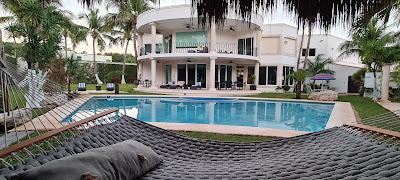

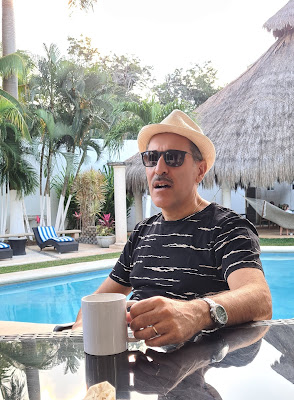
















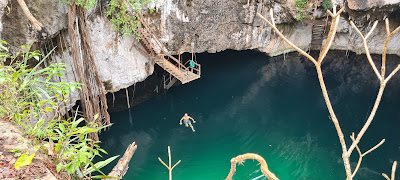


.jpg)













































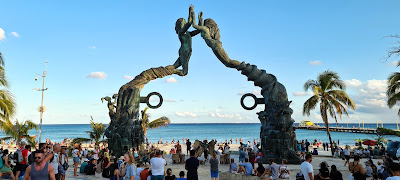



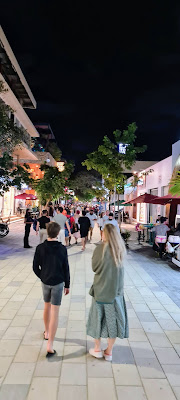



































No comments:
Post a Comment